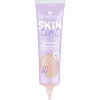What's inside
What's inside
 Key Ingredients
Key Ingredients

 Benefits
Benefits

 Concerns
Concerns

 Ingredients Side-by-side
Ingredients Side-by-side

Water
Skin ConditioningTitanium Dioxide
Cosmetic ColorantTributyl Citrate
SolventButylene Glycol
HumectantDicaprylyl Ether
EmollientEthylhexyl Triazone
UV AbsorberMyristyl Lactate
EmollientC13-15 Alkane
SolventSilica
AbrasiveDiethylamino Hydroxybenzoyl Hexyl Benzoate
UV FilterBis-Ethylhexyloxyphenol Methoxyphenyl Triazine
Skin ConditioningPolyglyceryl-6 Polyricinoleate
EmulsifyingPolyglyceryl-6 Polyhydroxystearate
EmulsifyingTalc
AbrasiveMagnesium Sulfate
Dimethicone/Vinyl Dimethicone Crosspolymer
Skin ConditioningAloe Barbadensis Leaf Juice Powder
Skin ConditioningSodium Hyaluronate
HumectantTocopherol
AntioxidantCetyl Alcohol
EmollientDextrin Palmitate
EmulsifyingPolyglycerin-6
HumectantXanthan Gum
EmulsifyingTriethoxycaprylylsilane
Phenoxyethanol
PreservativeCI 77491
Cosmetic ColorantCI 77492
Cosmetic ColorantCI 77499
Cosmetic ColorantWater, Titanium Dioxide, Tributyl Citrate, Butylene Glycol, Dicaprylyl Ether, Ethylhexyl Triazone, Myristyl Lactate, C13-15 Alkane, Silica, Diethylamino Hydroxybenzoyl Hexyl Benzoate, Bis-Ethylhexyloxyphenol Methoxyphenyl Triazine, Polyglyceryl-6 Polyricinoleate, Polyglyceryl-6 Polyhydroxystearate, Talc, Magnesium Sulfate, Dimethicone/Vinyl Dimethicone Crosspolymer, Aloe Barbadensis Leaf Juice Powder, Sodium Hyaluronate, Tocopherol, Cetyl Alcohol, Dextrin Palmitate, Polyglycerin-6, Xanthan Gum, Triethoxycaprylylsilane, Phenoxyethanol, CI 77491, CI 77492, CI 77499
Water
Skin ConditioningIsoamyl Laurate
EmollientCaprylic/Capric Triglyceride
MaskingHydrogenated Didecene
Skin ConditioningButylene Glycol
HumectantCetyl PEG/PPG-10/1 Dimethicone
EmulsifyingHydrogenated Styrene/Isoprene Copolymer
Polyglyceryl-4 Isostearate
EmulsifyingTalc
AbrasiveEthylhexyl Hydroxystearate
EmollientPropylene Glycol
HumectantGlycerin
HumectantSodium Hyaluronate
HumectantSodium PCA
HumectantUrea
BufferingPolyquaternium-51
Skin ConditioningPhenoxyethanol
PreservativeCaprylyl Glycol
EmollientChlorphenesin
AntimicrobialTriethoxycaprylylsilane
Disodium EDTA
Trehalose
HumectantPentaerythrityl Tetra-Di-T-Butyl Hydroxyhydrocinnamate
AntioxidantHexylene Glycol
EmulsifyingTriacetin
AntimicrobialCI 77163
Cosmetic ColorantCI 77891
Cosmetic ColorantIron Oxides
Water, Isoamyl Laurate, Caprylic/Capric Triglyceride, Hydrogenated Didecene, Butylene Glycol, Cetyl PEG/PPG-10/1 Dimethicone, Hydrogenated Styrene/Isoprene Copolymer, Polyglyceryl-4 Isostearate, Talc, Ethylhexyl Hydroxystearate, Propylene Glycol, Glycerin, Sodium Hyaluronate, Sodium PCA, Urea, Polyquaternium-51, Phenoxyethanol, Caprylyl Glycol, Chlorphenesin, Triethoxycaprylylsilane, Disodium EDTA, Trehalose, Pentaerythrityl Tetra-Di-T-Butyl Hydroxyhydrocinnamate, Hexylene Glycol, Triacetin, CI 77163, CI 77891, Iron Oxides
Ingredients Explained
These ingredients are found in both products.
Ingredients higher up in an ingredient list are typically present in a larger amount.
Butylene Glycol (or BG) is used within cosmetic products for a few different reasons:
Overall, Butylene Glycol is a safe and well-rounded ingredient that works well with other ingredients.
Though this ingredient works well with most skin types, some people with sensitive skin may experience a reaction such as allergic rashes, closed comedones, or itchiness.
Learn more about Butylene GlycolPhenoxyethanol is a preservative that has germicide, antimicrobial, and aromatic properties. Studies show that phenoxyethanol can prevent microbial growth. By itself, it has a scent that is similar to that of a rose.
It's often used in formulations along with Caprylyl Glycol to preserve the shelf life of products.
Sodium Hyaluronate is hyaluronic acid's salt form. It is commonly derived from the sodium salt of hyaluronic acid.
Like hyaluronic acid, it is great at holding water and acts as a humectant. This makes it a great skin hydrating ingredient.
Sodium Hyaluronate is naturally occurring in our bodies and is mostly found in eye fluid and joints.
These are some other common types of Hyaluronic Acid:
Learn more about Sodium HyaluronateTalc is a clay mineral. It helps absorb moisture and improve the texture of products. Like other types of clay, Talc can have a slight exfoliating effect on skin. Talc can be added to increase the volume of products.
Some Baby powders are made by combining talc with corn starch. The word "talc" comes from Latin and originates from Arabic. Talc is a mineral commonly found throughout the world.
If you have any concerns about using talc, we recommend checking out the FDA's official page.
Learn more about TalcTriethoxycaprylylsilane is a silicone used to bind and stabilize ingredients.
As an emulsifier, it helps prevent ingredients from separating. This can help elongate the shelf life of products.
Triethoxycaprylylsilane is often used to coat mineral sunscreens ingredients to help give a better feel. It also helps reduce oxidative stress in sunscreens.
Learn more about TriethoxycaprylylsilaneWater. It's the most common cosmetic ingredient of all. You'll usually see it at the top of ingredient lists, meaning that it makes up the largest part of the product.
So why is it so popular? Water most often acts as a solvent - this means that it helps dissolve other ingredients into the formulation.
You'll also recognize water as that liquid we all need to stay alive. If you see this, drink a glass of water. Stay hydrated!
Learn more about Water